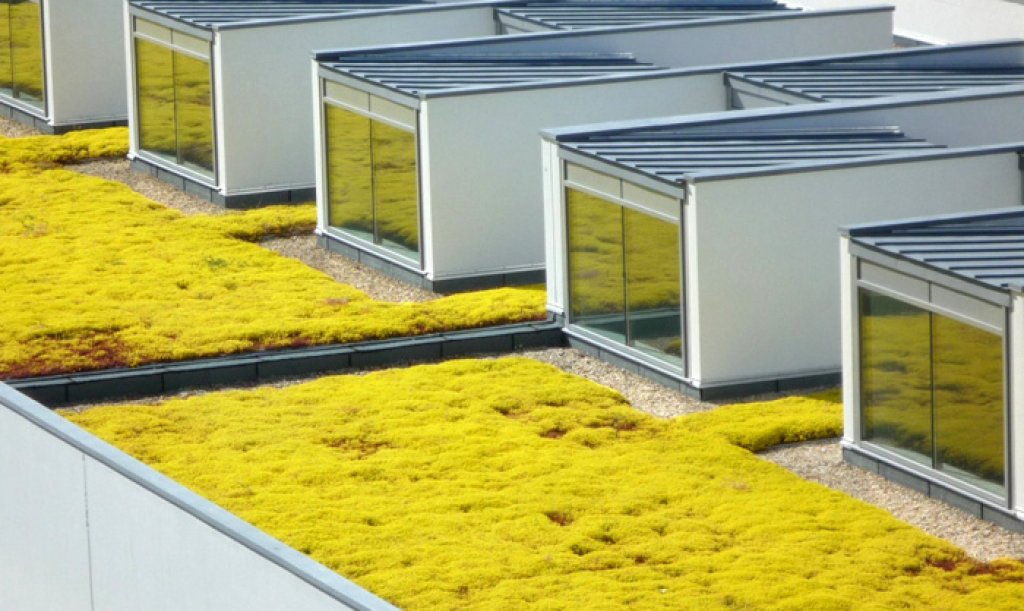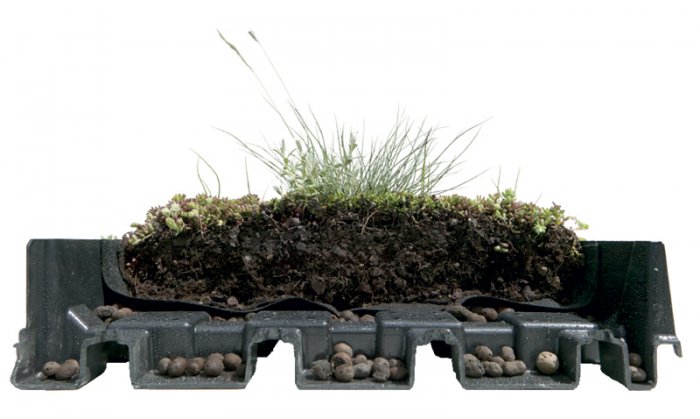A vegetated roof, also known as a green roof, living roof, or eco roof is a planting system where materials and plants are installed on the top of a building. The vegetation is designed to be independent as a result of selecting plants capable of developing into a stable ecosystem.
The 3 types of green roof
The extensive green roof should be distinguished from the traditional roof garden. Light and fairly thin, the plant system can be established on any type of support (such as wood or steel). The selected group of plants requires very little maintenance and develops into a stable ecosystem. Finally, the extensive green roof is a system that is generally inaccessible to pedestrians: the movement of people is limited to maintaining a watertight roofing membrane and the health of the plants. Three types of green roofs exist: extensive, semi-intensive, and intensive green roofs.
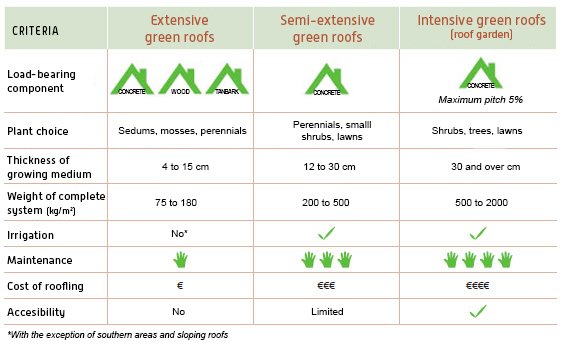
Comparison of the various green roofs
An extensive green roof is characterised by its low weight, a thin layer of growing medium (green substrate), a mix of plants adapted to conditions on the roof, minimum maintenance and low installation costs. A semi-intensive green roof has a thicker layer of growing medium in order to broaden the range of plants, but involves more maintenance and irrigation systems are sometimes essential.
 Examples of extensive green roofs produced by Vegetal i.D.
Examples of extensive green roofs produced by Vegetal i.D.
 Examples of semi-intensive green roofs produced by Vegetal i.D.
Examples of semi-intensive green roofs produced by Vegetal i.D.
The Components of a Green Roof
The green roof consists of 8 superimposed layers (1 to 8).
- The load-bearing component of the roof
- The moisture barrier
- The thermal insulator
- The waterproofing membrane (root barrier)
- The drainage layer
- The filtering layer
- The growing medium (substrate)
- The plant layer
The green roof can be established on any load-bearing components (concrete, tanbark, wood). However, the choice of vegetated system must be suitable to load-bearing capacity of the building's roof. Drainage paths provide a way for excess water to reach rainwater drainage devices. The filter prevents any material from clogging between the growing medium and the drainage layer. Layers 4 to 8 form the green roof system.
A water supply with a capacity appropriate for the size of the planted area must be provided on the roof in order to protect the plants in the case of a prolonged dry period.
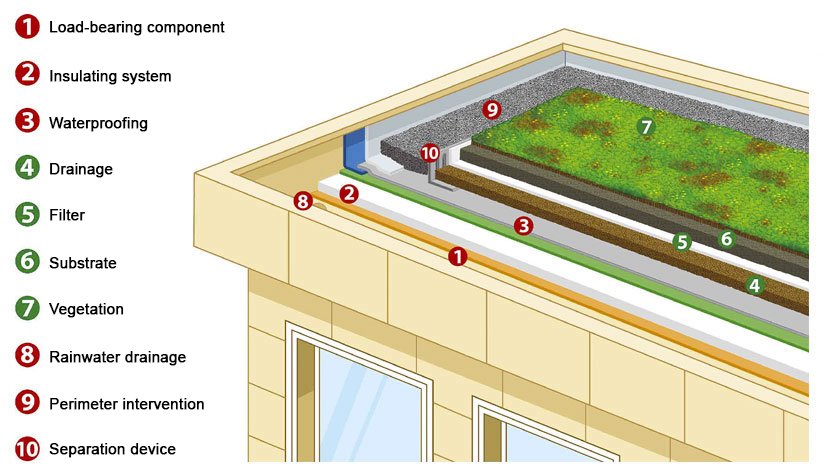 Basic cross sectional drawing of a green roof
Basic cross sectional drawing of a green roof
The Various Planting Systems
There are several planting systems engineered for green roofing: pre-planted systems (green roof tray and sedum mat) and multi-layer systems (by inserting plant plugs or by spreading sedum cuttings).

The various Vegetal i.D.® planting techniques
Ready-to-Place "all-in-one" Green Roof System
This modular system incorporates all the layers of a green roof system (drain, filter, growing medium and plants) grouped together in one unit known as a tray, module or paver. This easy-to-use pre-planted tray is a quick and low maintenance way to install a lush green roof quickly!
Vegetal i.D. designed and developed the first pre-planted tray with a water reservoir in 2005: the HYDROPACK® tray. As of 2014 it remains the only all-in-one pre-planted module approved by building professional. It is suitable for all kind of roof : from flat roofs to roofs with a pitch of up to 200%.
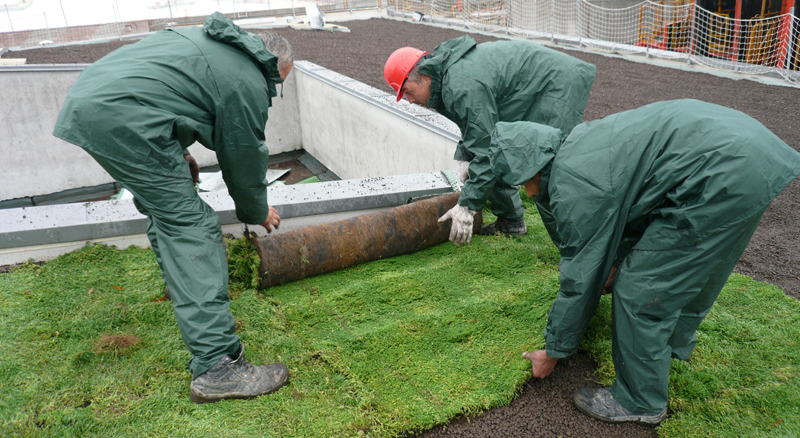 Installing the sedum mat
Installing the sedum matSedum Mat Pre-Planted Systems
The mat-based vegetated system consists of a roll grown in the open field, unrolled and laid directly on the layer of growing medium and the usual layers of a system (drain, filter). Pre-planted mats allow the roof to be vegetated immediately and can be laid at almost any time of the growing season.
Vegetal i.D. grows pre-vegetated mats in its nursery. i.D. MAT mats are suitable for flat roofs and roofs with pitches of up to 100%.
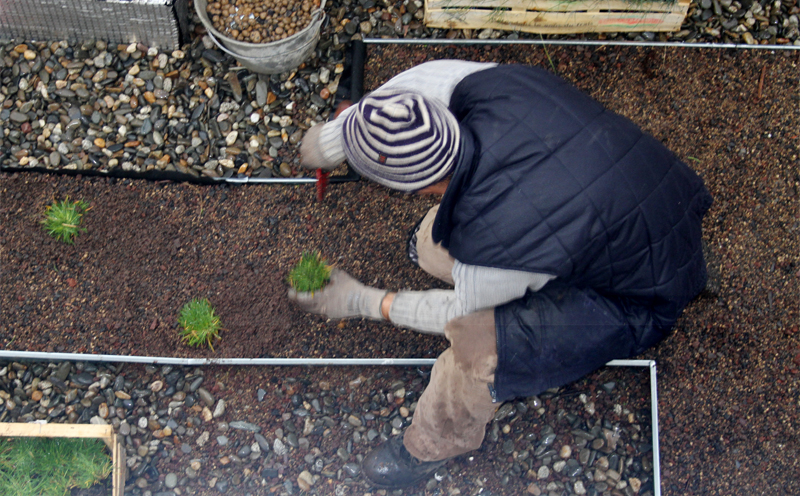 Planting i.D. MOTTE micro-plugs on a green roof
Planting i.D. MOTTE micro-plugs on a green roofVegetated Systems based on Plugs or Potted Plants
Planting plug plants or potted plants on roofs means that there can be a variety of plants on the green roof. Establishing this vegetated system is only possible in spring or autumn in order to optimize the rooting of plants in the growing medium. The level of plant cover reaches 80% after a period of 12 to 24 months.
Vegetal i.D. grows i.D. MOTTE sedum and perennial plug plants in its nursery.
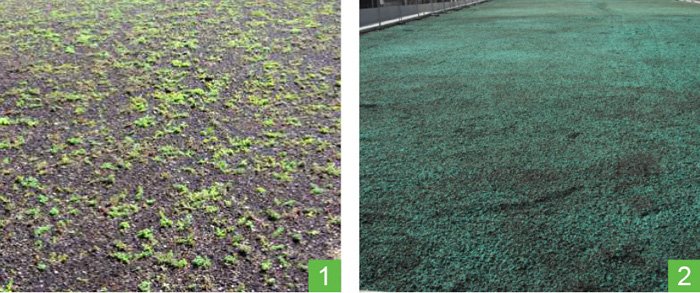 Aesthetic appearance of a green roof produced by spreading sedum cuttings. 1. Using manual spreading 2. Using hydraulic mulch seeding
Aesthetic appearance of a green roof produced by spreading sedum cuttings. 1. Using manual spreading 2. Using hydraulic mulch seedingCutting–Based Vegetated Systems
The vegetated system integrated by spreading cuttings is particularly well-suited to large-scale projects (over 1000 m²). Quick and easy to use, the level of plant cover reaches 80% after a period of between 18 and 36 months.
Vegetal i.D. grows i.D. FRAGMENTS cuttings from sedums and perennials at its plant nursery in France.



